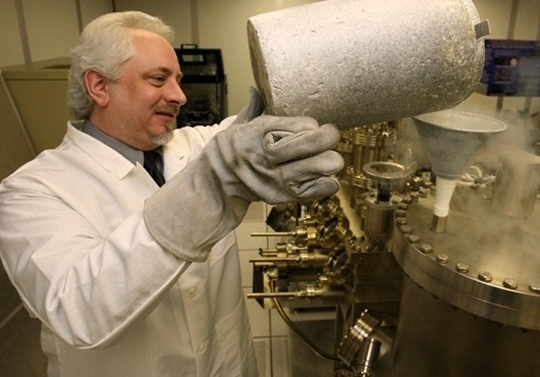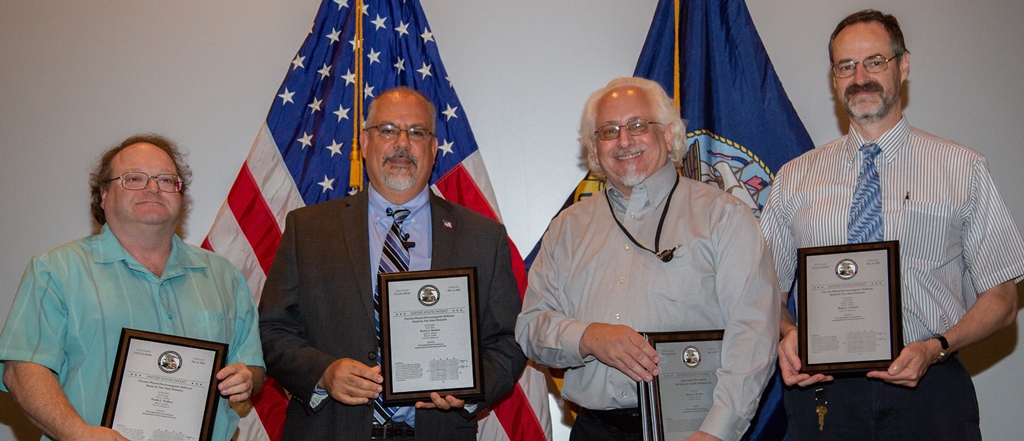 DAHLGREN, Va. - Dr. Kevin Boulais uses liquid nitrogen in a molecular beam epitaxy system to create photo capacitors for light guide film applications at Naval Surface Warfare Center Dahlgren Division (NSWCDD). Boulais - among 32 inventors honored at the NSWCDD Patent Awards ceremony on July 19, 2018 - was recognized for his work on a patented innovation called, 'Light Guide Film Control for Optically Tunable Metamaterials'. Dr. Francisco Santiago and Dr. Charles Mannix were also honored for their work on the invention which pairs light guide films with photo-sensitive or photo-reactive metamaterials. The warfighter is provided with an optically controlled electrical element having a wide range of uses. For example, the invention will secure communication without the communicator having to transmit and it will network electronics, sensors, and radiating elements in a similar fashion. The light guide film will also improve flexible electronics. In other words, there will be "no copper interconnects to break," said Boulais. (U.S. Navy photo by D. Kevin Elliott/Released)
DAHLGREN, Va. - Dr. Kevin Boulais uses liquid nitrogen in a molecular beam epitaxy system to create photo capacitors for light guide film applications at Naval Surface Warfare Center Dahlgren Division (NSWCDD). Boulais - among 32 inventors honored at the NSWCDD Patent Awards ceremony on July 19, 2018 - was recognized for his work on a patented innovation called, 'Light Guide Film Control for Optically Tunable Metamaterials'. Dr. Francisco Santiago and Dr. Charles Mannix were also honored for their work on the invention which pairs light guide films with photo-sensitive or photo-reactive metamaterials. The warfighter is provided with an optically controlled electrical element having a wide range of uses. For example, the invention will secure communication without the communicator having to transmit and it will network electronics, sensors, and radiating elements in a similar fashion. The light guide film will also improve flexible electronics. In other words, there will be "no copper interconnects to break," said Boulais. (U.S. Navy photo by D. Kevin Elliott/Released)DAHLGREN, Va. (July 24, 2018)—A father and son team were among 32 inventors honored at the Naval Surface Warfare Center Dahlgren Division (NSWCDD) Patent Awards ceremony, July 19.
Gerhard Thielman and his son, Benjamin—among 32 patent holders recognized for 12 patents—collaborated to invent the 'Spherical Tractor Operating Mobile Platform'.
"The potential benefit to the warfighter is an adaptable, self-contained vehicle with multi-mission capability," NSWCDD Chief of Staff Chuck Campbell told an audience of the inventors' family, friends and colleagues regarding the Thielmans' innovation.
The patents represent a culmination of effort by many individuals, including the inventors, the Invention Evaluation Board members, patent attorneys, and others who conceive—and reduced to practice—the technological innovations arising from the command's research and development activities.
"As we celebrate 100 years of excellence in bringing innovative solutions to the warfighter and the military at large, today marks another milestone at Dahlgren," said keynote speaker, NSWCDD Technical Director John Fiore. "This is another example of why we foster a work environment that cultivates endless possibilities to positively shape our global defense strategy. I salute our amazing inventors who have made their marks in Dahlgren history. You are leaving a lasting imprint on our military, nation and commerce."
NSWCDD innovations are patented to benefit the taxpayer, the Navy, and the command's inventors. The command's rigorous patent program protects the government's intellectual property generated during the research and development process.
"The technical transfer of these patents into the public domain saves the Navy money and increases product availability," said Fiore, pointing out that this technical transfer has already impacted multi-mission capabilities, produced a quicker and easier construct of modeling and simulation programs, and increased the aiming accuracy for warfighters, decreasing the time weapons are out of service.
Moreover, the patents provide a technological return to the taxpayer by licensing the command's inventions to U.S. businesses so they may be commercially developed for public use. The patents provide defensive protection for the Navy so that others cannot obtain patents to Navy inventions, preventing the Navy from using its own inventions. The patents also increase international recognition and enable potential financial remuneration for the inventors of useful, novel, and non-obvious inventions.
"We are honored to celebrate some of our nation's best and brightest innovators who have developed inventions that will reap perpetual rewards for the warfighter, the military, our country and commercial enterprise," said Campbell, the ceremony's moderator, before calling up the inventors—one patent at a time.
Fiore presented the patent holders with a plaque reproduction of the patent certificate issued by the U.S. Patent and Trademark Office after Campbell described each patent as follows:
Spherical Tractor Operating Mobile Platform
This invention is a highly-maneuverable vehicle having an outer spherical shell that is propelled along the ground, an inner cockpit for manned uses or equipment pod for unmanned uses, and a motor that propels the sphere via tensioned drive wheels internal to the spherical shell. The potential benefit to the warfighter is an adaptable, self-contained vehicle with multi-mission capability. Patent awardees—Gerhard Thielman, Benjamin Thielman.
Modular Model and Simulation Architecture
This invention provides a computer architecture that greatly reduces the cost and effort to create a modeling and simulation software. The warfighter is provided with quicker and easier construction of modeling and simulation programs to design and improve systems. Patent awardees—Clinton Winfrey, Benjamin Baldwin and Dr. Mary Ann Cummings.
Light Guide Film Control for Optically Tunable Metamaterials
This invention pairs light guide films with photo-sensitive or photo-reactive metamaterials. The warfighter is provided with an optically controlled electrical element having a wide range of uses. Patent awardees—Dr. Kevin A. Boulais, Dr. Francisco Santiago, and Dr. Charles Mannix.
Optically Controllable Composite Dielectric
This invention provides a new component that is responsive to light to tune, or control a circuit optically. The warfighting capability provided by this invention is a new tuning element that can be adapted to a wide variety of needs in Navy systems. Patent awardees—Dr. Kevin Boulais, Dr. Simin Feng, Dr. Pearl Rayms-Keller, Dr. Michael Lowry, and Dr. Francisco Santiago.
Discrete Phased Electromagnetic Reflector Based on Two-State Elements
This invention is an efficient means of "steering" electromagnetic waves such as are used in radar and communications. By this invention, the warfighter is provided with a means to precisely guide electromagnetic beams over a broader range of frequencies than was possible before using spatial digitization. Patent awardees—Dr. Simin Feng, Dr. Kevin Boulais, Frank Wallace, Blaise Corbett and Dr. Victor Gehman, Jr.
Impregnation of Macrocycle Organics to Activated Carbon
This invention relates to improvements in filtration materials used, for example, in gas masks and other devices by ensuring that activated carbon and associated materials remain evenly distributed throughout the filter medium. This benefits the warfighter by improving both the effectiveness and lifecycle of the filter materials. Patent awardees—Dr. Joseph Hunt and Dr. Timothy Burgin.
Mechanism to Adjust and Restrain Gun Traverse on a Tripod Mount (NC 103685)
This invention provides a reliable and durable way of controlling the field of fire of a tripod-mounted weapon. The warfighter benefits by having a reliable mechanism to restrict the field of fire when necessary, enabling the machine gunner to operate with less concern for hitting friendly flanking positions. Patent awardees—Stephen Dix, Tracy White and Arturo Lopez.
Tripod mount with a Traverse Support Mechanism
This invention is a durable weapons tripod that is easily stowed and deployed. The warfighter is provided with a reliable tripod mount that reduces logistics concerns. Patent awardees—Stephen Dix and Tracy White.
Fixed Optic for Boresight
The current invention describes a device that is a lightweight and accurate bore siting device for weapons such as mortars. The benefits to the warfighter are increased aiming accuracy, less time the weapon is out of service, and decreased costs for servicing the weapon. Patent awardees—James Travis Robbins, Luis Rodriguez and Danny Wilson.
Detection and Detonation of Improvised Explosive Device with Magnetic Fields
This invention contributes a method of detection of IEDs through the use of a magnetic field that is relatively unaffected by soil conditions such as water content. The benefit to the warfighter is an improved and reliable means to detect and dispose of IEDs. Patent awardee—Dr. James Camp.
Interleaving Angled Hexagonal Tile for Flexible Armor
This invention provides a new type of armor, especially for personnel, utilizing lightweight, specifically-shaped units of lightweight ceramic. The warfighter is thus provided with a lightweight flexible armor that prevents penetration, reduces impact, and increases protection against multiple hits. Patent awardees—Dr. Justin Blair and Dr. Raymond Gamache.
Maritime Emergency Cable Cutter
This invention is a remotely-triggered explosive device shaped and positioned on a cable for emergency use. This invention benefits the warfighter by eliminating the need for manual cable cutting, providing instead a wireless encrypted means to remotely detonate a relatively small explosive device to sever a cable when necessary. Patent awardee—Steven Anderson.
"These historic licensing agreements are a direct result of our employees' ingenuity in creating technological solutions for our warfighters and Fleet," said Fiore. "We are so proud of all of our patent awardees. You are integral problem solvers who identified a need, assessed the problem, and refused to quit until you found a solution. Your work is a result of hours of planning, brainstorming, prototyping and sometimes having to go back to the drawing board."



